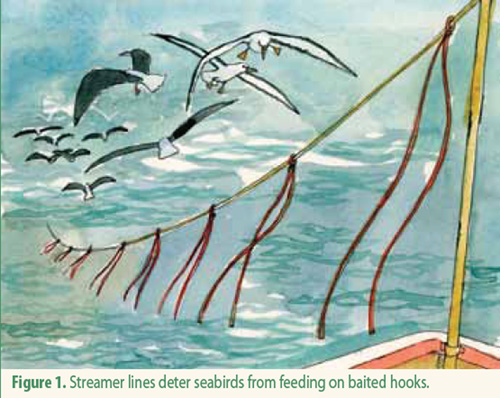Noriyosi Sato (National Research Institute of Far Seas Fisheries, Japan) and colleagues have published in the open-access journal PLoS ONE on the efficacy of different designs of bird-scaring lines in the North Pacific, finding little differences in attack rates on baited hooks by Laysan Albatrosses Phoebastria immutabilis.
The paper's abstract follows:
"To improve the effectiveness of tori-lines it is necessary to evaluate the ability of tori-lines to mitigate seabird bycatch and determine what kind of seabird species gather during line settings, attack the bait and are incidentally caught. We conducted two experiments in the western North Pacific and examined the effectiveness for seabird mitigation of light streamer tori-lines which have no long streamers but many light (short) streamers and are mainly used in the North Pacific area. Firstly, the effectiveness of two different types of tori-line (light streamer (1 m) and long streamer (up to 7 m) tori-line) and of two different colors (yellow and red) of light streamers for seabird bycatch avoidance was evaluated using 567 sets based on data from 20 offshore surface commercial longliners. No significant difference in the bycatch number between the different tori-line types and streamer colors was found. Secondly, we investigated the characteristics of the seabird bycatch in the North Pacific and the effectiveness of three different types of streamers (light, hybrid and modified light types) by detailed observations of seabird attacks using a chartered longline vessel. Although the appearance rate of albatrosses and shearwaters were 40.9% and 27.7%, Laysan albatross was the main seabird species that followed the vessel but shearwaters seldom followed the vessel and did not aggregate during line setting. In all attacks on bait observed during line settings, 81% and 7% were by albatrosses and shearwaters, respectively. In the number of primary attacks by Laysan albatrosses which attacked most aggressively of all seabirds, there were no significant differences among the tori-line types. No individuals of shearwater were caught. The results of both experiments indicated that light streamer tori-lines were as effective as tori-lines with long streamers for mitigating seabird bycatch in the North Pacific."

Reference:
Sato, N., Ochi, D., Minami, H. & Yokawa, K. 2012. Evaluation of the effectiveness of light streamer tori-lines and characteristics of bait attacks by seabirds in the western North Pacific. PLoS ONE 7(5): e37546. doi:10.1371/journal.pone.0037546.
John Cooper, ACAP Information Officer, 12 June 2012

 English
English  Français
Français  Español
Español